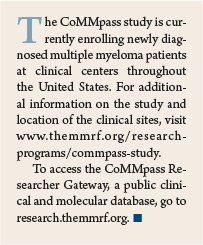In 2011, the Multiple Myeloma Research Foundation (MMRF) announced the launch of CoMMpass (Relating Clinical Outcomes in Multiple Myeloma to Personal Assessment of Genetic Profile), a clinical study at the heart of its Personalized Medicine Initiative. CoMMpass will follow 1,000 newly diagnosed patients with multiple myeloma over the course of 8 years to better understand the molecular and genetic components of the cancer and how they contribute to disease progression and to an individual patient’s response to therapy. The study also aims to generate new leads for targeted drug development.
So far, nearly 500 patients have been accrued into the study, which has a 3-year enrollment time frame and 5-year follow-up. Full accrual is expected by the end of the year.
The design of CoMMpass includes the serial collection of paired bone marrow aspirate and peripheral blood throughout the study to catalogue genomic changes in a patient’s disease from onset to remission and relapse. The biospecimens will then undergo whole-genome, whole-exome, and RNA sequencing; immunophenotyping; and BRAF sequencing. (An interim analysis of tumor specimens of 178 patients has identified BRAF V600E mutations at a rate of 5.7%.1) Genomic analysis on all patient samples will be performed at the Translational Genomics Research Institute (TGen) in Phoenix.
The ASCO Post talked with Sagar Lonial, MD, Principal Investigator of the CoMMpass study and Vice Chair of Clinical Affairs, Department of Hematology and Medical Oncology, Winship Cancer Institute of Emory University, Atlanta, about the goals of CoMMpass and how its findings could influence personalized care for patients with myeloma, provide new drug targets, and determine the classification of multiple myeloma subtypes.
CoMMpass Components
As part of the CoMMpass trial, patient tumor samples are being collected and analyzed at the time of diagnosis, at clinical remission, and at disease progression. What will the molecular and genomic analysis at these different points tell you about an individual patient’s disease?
There are really two big components to CoMMpass. The first is the molecular characterization of a patient’s tumor using sequencing at the time of initial presentation and then trying to longitudinally follow what happens to that patient after treatment. We want to know how good the patient’s response is over time and how the sequencing mutation discovered at initial diagnosis impacts those clinical characteristics, including response and duration of response.
Then, if and when the disease comes back, we want to know whether there were changes in the mutations or if new mutations developed that were influenced by the therapy or by the original presentations of the mutations themselves. That is really the big-picture question.
Treatment Challenges
Will determining the molecular changes myeloma undergoes during first-line treatment enable oncologists to more effectively treat a patient’s subsequent cancer recurrences?
Yes, that’s correct. The front-line treatments permitted in CoMMpass include standard-of-care therapies containing a proteasome inhibitor, an immunomodulatory drug, or both. We are trying to understand whether the efficacy of the initial induction therapy is influenced by the molecular characteristics of the tumor at diagnosis. We want to learn why some patients do exceedingly well on a specific type of drug, while other patients do not do as well and may need multiple drugs to keep their myeloma from advancing.
Does the molecular diversity of multiple myeloma make it distinct from other blood cancers and more difficult to successfully treat?
As we learn more about cancer and its various types, we lump those types together less and split them into more individual diseases. Many years ago, lymphomas were characterized as six or seven different types; now we know that there are at least 50 different types. So the molecular characterization of lymphoma has been an important way to give lymphoma subtypes different names and potentially treat them in different ways. We may need to do that in myeloma.
In describing and treating myeloma, we’ve been limited by what a pathologist can see under a microscope. We now know that there is much more to the cancer than can be seen microscopically. Getting to its molecular characterization will help us to differentiate the subtypes of myeloma and potentially outline different treatment algorithms for them.
Through gene-expression profiling, we have been able to discern seven subtypes of myeloma. But in the CoMMpass study, we will be able to have individual tumor specimens molecularly sequenced, which has never been done before, and we will learn much more about the cancer and its subtypes. Gene-expression profiling is certainly useful, but it doesn’t give you all the information you need to treat myeloma. Molecular sequencing may help us identify not just the expression of genes involved in myeloma, but also potential mutations that could be targeted.
Bone Marrow Transplant
Now that there are so many effective targeted therapies that offer durable remissions, what is the role of bone marrow transplantation in the front-line treatment of myeloma?
We include transplantation as part of the treatment in the CoMMpass study. A number of the patients we have enrolled are getting a three-drug induction regimen; they have their stem cells collected and then move on to a transplant. And every time they have a bone marrow biopsy, a tissue sample is analyzed to look for evidence of minimal residual disease, which is an evolving area in the treatment of myeloma right now.
Minimal residual disease has played an important role in the progression of chronic myeloid leukemia, chronic lymphocytic leukemia, and other similar diseases. We have not really had therapies that are effective enough to evaluate minimal residual disease in myeloma patients until the past 5 years, so this is a question we are starting to address in the
CoMMpass study.
Now that we have more effective therapies, the role of bone marrow transplant in myeloma treatment is a question that is being tested in prospective randomized clinical trials. I think we’ll understand soon whether a transplant offers superior benefit in the context of all these great new therapies.
My sense is that with the data we have seen so far, if the goal is to eradicate all evidence of disease and consistently get patients to a [minimal residual disease]–negative state, bone marrow transplants continue to offer that ability. But there may be subsets of myeloma patients who don’t benefit from a transplant. There may be subsets of patients who are incredibly sensitive to the effects of high-dose melphalan (Alkeran) used in bone marrow transplantation induction therapy, and teasing that out based on molecular subtypes is part of what’s being done in clinical trials. Until we have that data, it is going to be hard to say, yes, everybody should keep getting transplants, or no, they should stop getting them.
The CoMMpass study is an incredibly important study, and I encourage every oncologist who takes care of patients with multiple myeloma to get them into this study, even if it means the patient has to travel to one of the clinical trial sites for a bone marrow biopsy (see the story below for a patient’s perspective on the CoMMpass study).
Although we have made many great inroads in this disease and have lots of new drugs, the real questions for the next decade are, how do we put these drugs together for the best outcome, and does a patient’s molecular subtype matter in terms of the drugs he gets? These are going to be the challenges over the next few years.
Impact on Quality of Life
The clinical endpoints and outcomes in the CoMMpass study include quality-of-life measures and health-care utilization. Why did you include these parameters in the study design?
We wanted to understand their impact on the patient. For example, we can say that patients should get a three-drug combination therapy as part of their initial treatment, but if the outcomes are similar to those of two-drug combinations and the side effects are less appreciable, we do a disservice to patients when we give them the three-drug combination.
We also want to know if there are molecular characteristics of a patient’s tumor that will tell us whether that patient will have side effects from a specific treatment. We will not be able to pin that down as well as you can in large randomized trials, but I think that we may get some clues about the impact of treatment on patients’ lives by tracking their side effects and quality-of-life incidents.
Looking Ahead
Based on what you are learning so far in CoMMpass and other clinical studies, do you think it will be possible to cure multiple myeloma or provide patients with very long durable remissions?
I think there are probably some patients we are curing now. It’s probably a relatively low percentage—between 5% and 10%—but I believe that CoMMpass will help us identify the best drug and the best targets to increase the cure rate in this disease.
The question of cure vs chronic disease is an important question to ask, and the answer may vary based on the type of molecular subtype a patient has. We now know that we can get myeloma patients to [minimal residual disease]–negative disease. The question is, is that low enough? If not, we need to push the barrier further, but do it in a way that does not compromise a patient’s quality of life. ■
Disclosure: Dr. Lonial is a consultant for Millennium, Celgene, Novartis, Bristol-Myers Squibb, Onyx, and Sanofi.
Reference
1. Keats J, Craig D, Liang W, et al: Interim analysis of the MMRF CoMMpass trial, a longitudinal study in multiple myeloma relating clinical outcomes to genomic and immunophenotypic profiles. 2013 ASH Annual Meeting. Abstract 532. Presented December 9, 2013.
The CoMMpass study is currently enrolling newly diagnosed multiple myeloma patients at clinical centers throughout the United States. For additional information on the study and location of the clinical sites, visit www.themmrf.org/research-programs/commpass-study.
To access the CoMMpass Researcher Gateway, a public clinical and molecular database, go to research.themmrf.org.



